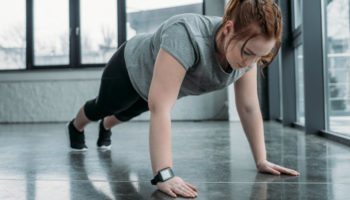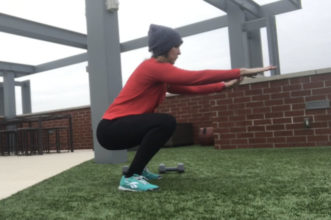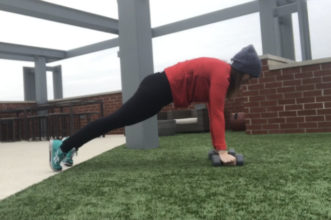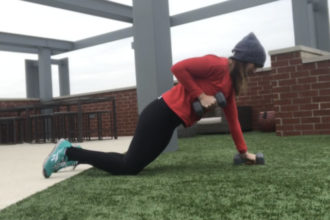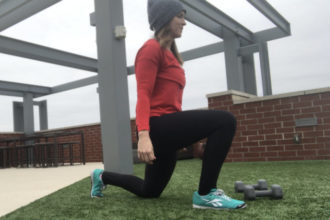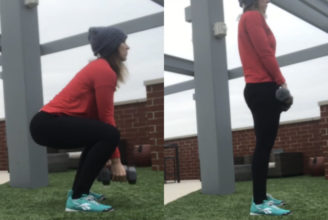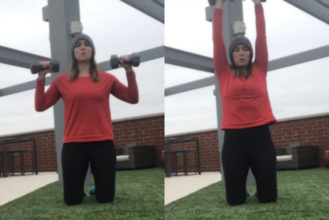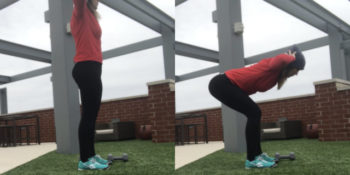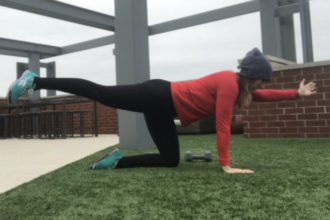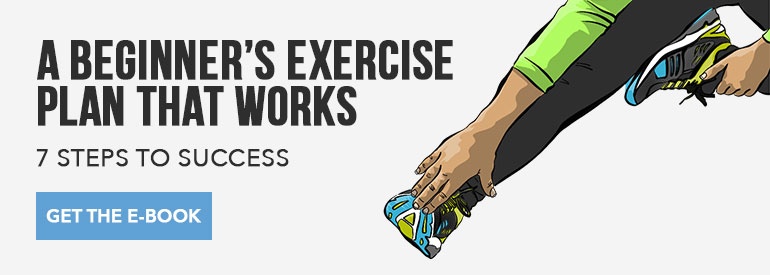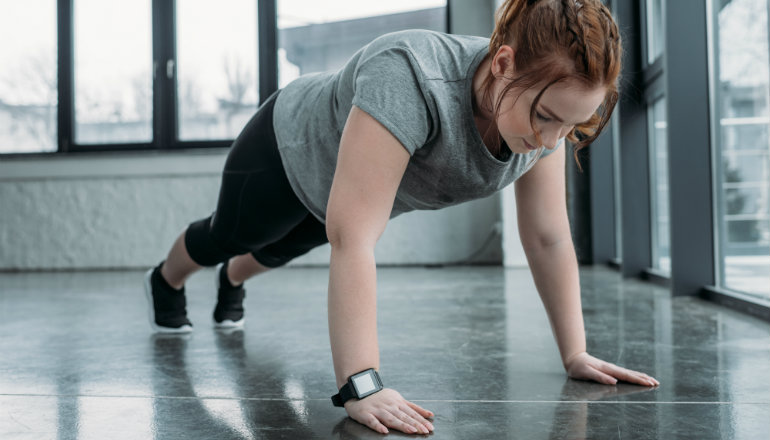 Reading Time: 7 minutes
Reading Time: 7 minutesThe world of exercise choices can seem like a maze. The overwhelming confusion of where to start and how to know where you’re headed turns many of us away. After all, there are far fewer choices to make from the comfort of the couch.
And now — Coach Liz comes to rescue.
Let me scoop you off your loveseat and open the doorway to movement by kicking off a new fitness routine with accessible movements and a focus on daily actions. From the comfort of your own home (or hotel room), let’s work together to get our blood pumping a bit, without too much soreness to follow.
Sold on getting started? Allow yourself to focus on lightweight, quality movements, working to build your muscular endurance by increasing repetitions over time.
First, I’ll show you the eight best exercises for beginners, then I’ll outline a training plan. (P.S. There will be opportunities in several of these exercises to increase intensity by adding dumbbells.)
1. Air Squat
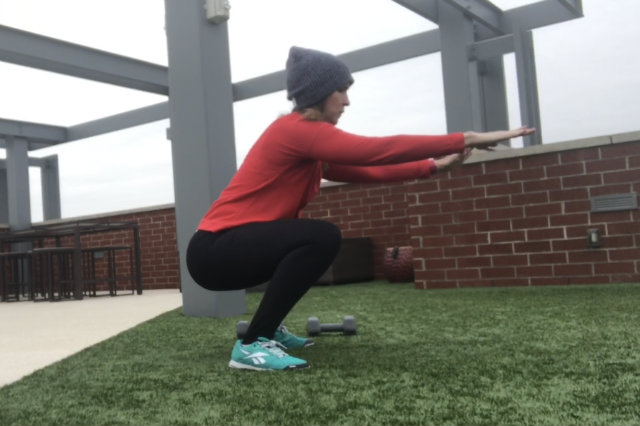
Daily movement replicated: Sitting and standing to a chair
Muscles trained: Glutes, quadriceps, hamstrings, inner thighs, calves
Form considerations: Lift the arms up as you drop your butt down. The arms will serve as a great counterbalance and allow for a more neutral spine. Work to get the hips below parallel. Squeeze the butt to stand. Push the hips forward at the top of the movement to finish.
Benefits: Improving range of motion, bone density, cardiovascular fitness
Modifications: Tight hips? Turn the feet out and take a wider base. Tender knees? Reduce range of motion to chair height. Consider tapping your butt to a chair as a depth check.
2. High Plank
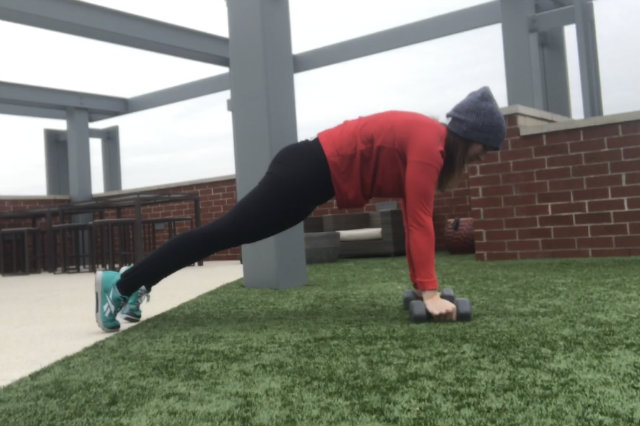
Daily movement replicated: Standing – think of this as standing on your feet only horizontally and with more influence from gravity
Muscles trained: Rectus abdominis, transverse abdominis, erector spinae, shoulders, and back
Form considerations: Dome the upper back and carve out the belly, pulling belly to spine, and creating what feels like a C-shape in the spine. Press the earth away. Hold for 10 seconds to start. (Match seconds with repetition recommendation from aforementioned rep scheme.) If you have sensitive wrists, gripping dumbbells can be a nice variation for more support.
Benefits: Improves core strength and shoulder stability. The more time you can spend in this position, the easier push-ups will become.
Modifications: Lower to low plank on elbows. To modify more, plank on your knees in a kneeling push-up position.
3. Modified Renegade Row
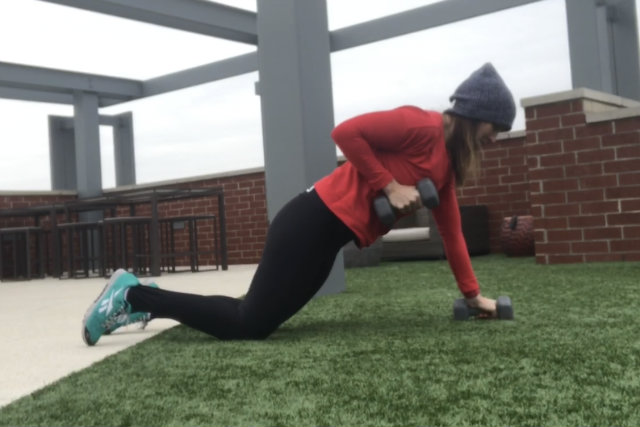
Daily movement replicated: Picking things up off the floor while in a hip hinge.
Muscles trained: Back, shoulders, biceps, triceps, core
Form considerations: Work to keep hips level, as you alternate pulling dumbbells off the ground. Keep elbow close to side and assure elbow passes the plane of your back to complete the movement. Keep core engaged by lightly pulling in the belly button.
Benefits: Hitting multiple muscle groups and training the core all in one. A great way to train the back without using a machine or a pull-up bar.
Amplification: Perform in high plank position.
4. Diagonal Lunges
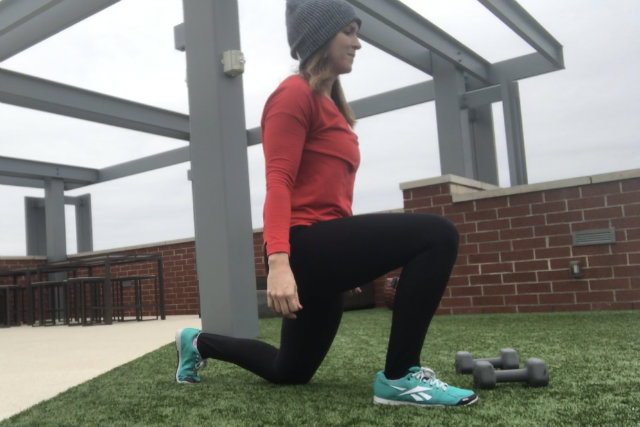
Daily movement replicated: Running, brisk walking, stair climbing
Muscles trained: Glutes, hamstrings, quadriceps. Back/core are stabilizers
Form considerations: Start with feet hip distance apart. Step out at a 45-degree angle touching back knee to the ground and return to starting position.
Benefits: Hip mobility, increasing muscular endurance for cardiovascular exercises such as running or hiking.
Modifications: Hold on to a wall or a chair for stabilization. Reduce range of motion to exclude knee tap if necessary.
5. Deadlift
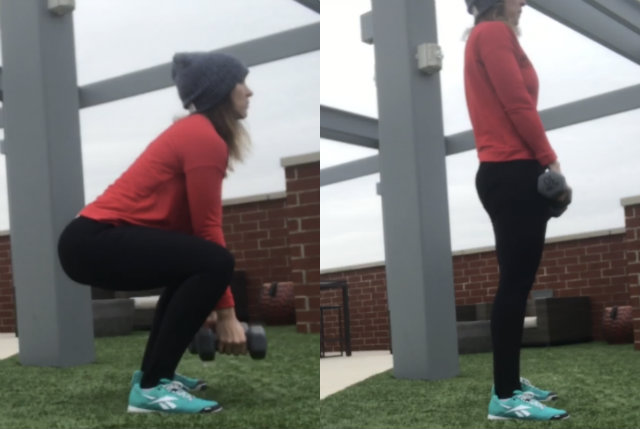
Daily movement replicated: Picking up kids, gift boxes, and other fun things
Muscles trained: spinal erectors, glutes, hamstrings, latissimus dorsi, upper back, core and forearms
Form considerations: Set dumbbells between the feet. Start with feet hip distance apart, or wider if necessary. Sit your butt back, look forward, and lower your butt down until your hands touch the dumbbells. Pick up the dumbbells, squeezing through the glutes to stand. Finish the movement by pushing the hips forward into full extension at the top of the movement.
Benefits: Deadlifts are secretly one of the best core exercises out there. As you stand into this movement, an engaged core will make the completion of the lift much easier.
Modifications: Set weights on top of a chair and deadlift from knee level.
6. Kneeling Overhead Press
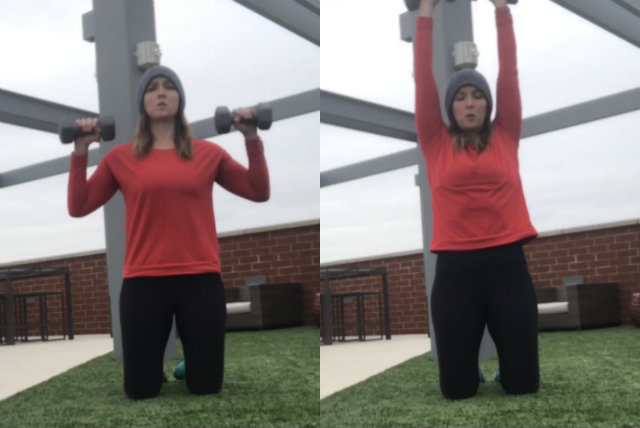
Daily movement replicated: Putting groceries in cupboards, or taking them out
Muscles trained: Shoulders, triceps
Form considerations: Kneel with knees under hips. Pull in core. Maintain palms facing forward throughout the exercise. Fully extend elbows at the top of the movement.
Benefits: Upper body strength, shoulder stabilization, core stabilization
Modifications: Lift one side at time. This will increase the core stabilization challenge but decrease the intensity of the lift on your upper body.
7. Bent-Knee Good Morning
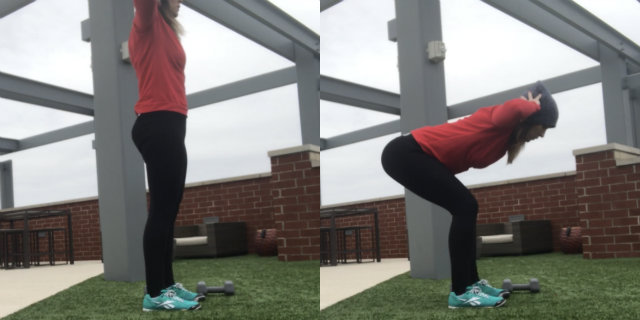
Daily movement modified: Standing up from leaning over; counterbalance to forward posture of desk-sitting and driving
Muscles trained: Erector spinae, gluteus maximus, hamstrings
Form considerations: Start with feet hip distance apart and hands behind the head. Use a light pressure in the hands against the head to force the chest open. Hinge from the hip, while bending the knees. Fold as close to parallel as you can. Press the head back into the hands to stand, squeezing the glutes for an added lift.
Benefits: Core strength, mobility
Modifications: Lie on your stomach on the floor, and perform a superman
8. Bird Dog
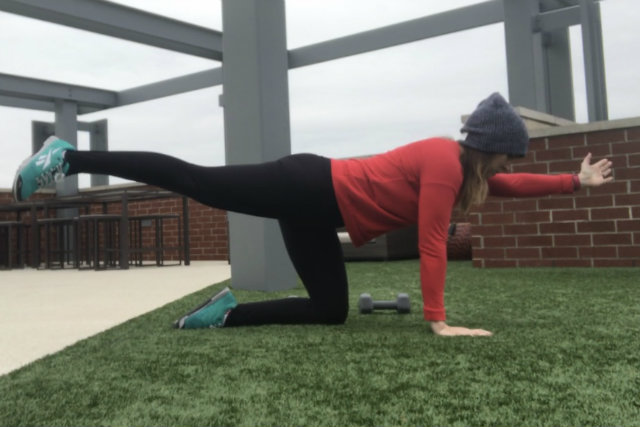
Daily movement replicated: Cross body balancing, replicating any time opposite hand and arm are off the ground
Muscles trained: Erector spinae, gluteus maximus, trapezius, rear deltoids
Form considerations: Start in a table-top position. On your exhale, lift opposite hand and foot and fully extend. Keep thumb facing ceiling at the top of the movement. Work to keep back level at the top of the movement.
Benefits: Core strength, engagement of the back side of the body in balance
Modifications: Lift only arms one at a time. Lift only legs one at a time.
What’s Not Included?
Well, a lot of things are not included, but if there’s one thing I bet you thought you’d see and did not, it’s the push-up. But, due to modern lifestyles, the majority of us already have tight and strong chests in comparison to the back of our bodies. Therefore, if we’re talking about the eight best exercise for a beginner, the push-up doesn’t make the cut.
Don’t get me wrong: the push-up is an awesome exercise and if I had to pick a ninth one, it’d be on the list. But for now, let’s focus on your core strength and back strength, and add the push-up into the next group of exercises you tackle.
How to Put This All Together (Your 8 Week Plan)
Start with 2 sets of 10 repetitions of these eight exercises. Work to build up to 3 sets of 20 repetitions by practicing these movements two to three times a week over two months.
Try this workout plan on Monday, Wednesday, and Friday:
- Week 1 – 2 sets of 10 repetitions
- Week 2 – 2 sets 12 repetitions
- Week 3 – 2 sets of 15 repetitions
- Week 4 – 2 sets of 20 repetitions
- Week 5- 3 sets of 10 repetitions
- Week 6 – 3 sets of 12 repetitions
- Week 7 – 3 sets of 20 repetitions
- Week 8 – 3 sets of 20 repetitions
Don’t worry about time and take whatever rest you need (and yes, that can be no rest at all).
That said, you’re only looking at about 10 minutes of exercise to get started on this plan. And if there’s anything I can guarantee, it’s that you’ll feel better once you’ve done it. Grab some dumbbells and let the exercise door open for you.
